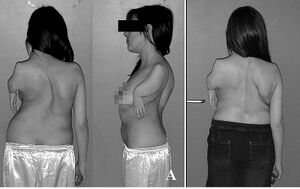Phocomelia
From WikiLectures
Phocomelia (from the Greek φωκη = „seal“ and μελος = „limb“[1] ) belongs to atrophic congenital defects of the upper (sometimes lower) limb.
Phocomelia was one of the typical components of the so-called thalidomide syndrome (at the turn of the 1960s, around 6,000 children were born worldwide with various malformations caused by the teratogenic effect of thalidomide - see Congenital developmental defects for more details ).[2]
Definition[edit | edit source]
- Complete longitudinal defect on the upper limb of the humerus, radius, ulna, possibly the carpus + on the lower limb of the femur, tibia, fibula, possibly the tarsus.
- On the upper limb, a more or less normal hand sits directly on the shoulder girdle, on the lower limb, the foot on the pelvic girdle.[3]
Therapy[edit | edit source]
- Individuals affected by phocomelia of the upper limbs mainly used preserved lower limbs for self-care.
- Today, we solve this defect with tension / electric prostheses, controlled by a phocomelic hand.
- Phocomelia of the lower limbs is treated prosthetically as a bilateral disarticulation in the hip joint.[3]
Links[edit | edit source]
External links[edit | edit source]
References[edit | edit source]
- ↑ MedicineNet. Definition of Phocomelia [online]. [cit. 27.9.2009]. <www.medterms.com>.
- ↑ KALTER, H.. Teratology in the Twentieth Century. Congenital Malformations in Humans and how their Environmental Causes were Established. 1. edition. Amsterdam : Elsevier, 2003. 166 pp. ISBN 978-0-444-51364-9.
- ↑ a b SOSNA, A. – VAVŘÍK, P., et al. Základy ortopedie. 1. edition. Praha : Triton, 2001. ISBN 80-7254-202-8.

